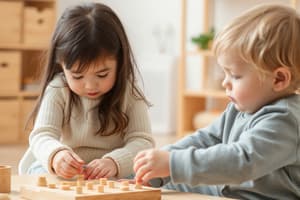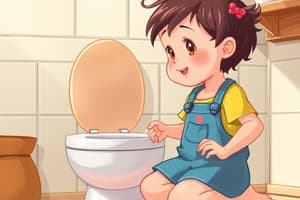Podcast
Questions and Answers
What is the primary characteristic of preoperational thought between the ages of 18 to 24 months?
What is the primary characteristic of preoperational thought between the ages of 18 to 24 months?
- Understanding that one object can represent another (correct)
- Reaching limited conservation ability
- Advanced problem-solving abilities
- Ability to think logically about multiple variables
Which feature describes centration in preoperational thought?
Which feature describes centration in preoperational thought?
- Understanding spatial relationships
- Maintaining multiple viewpoints simultaneously
- Focusing on one variable in a situation (correct)
- Recognizing changes in quantity despite appearance
What does the 'grammar explosion' refer to in language development?
What does the 'grammar explosion' refer to in language development?
- A surge in a child's vocabulary
- The use of complex sentences from an early age
- The introduction of irregular verbs in speech
- The rapid development of grammatical understanding (correct)
How do studies on adopted children relate to IQ development?
How do studies on adopted children relate to IQ development?
What is a limitation of assessing children in specific subjects?
What is a limitation of assessing children in specific subjects?
In Vygotsky’s sociocultural perspective, what is emphasized in cognitive development?
In Vygotsky’s sociocultural perspective, what is emphasized in cognitive development?
Which aspect of fast-mapping is crucial for language development?
Which aspect of fast-mapping is crucial for language development?
What is a key effect of practice and maturation on operational efficiency in cognitive development?
What is a key effect of practice and maturation on operational efficiency in cognitive development?
At what age do children typically begin to climb on furniture unaided?
At what age do children typically begin to climb on furniture unaided?
Which fine-motor skill is typically developed by children aged 3-4 years?
Which fine-motor skill is typically developed by children aged 3-4 years?
What is a main function of the left hemisphere of the brain during early childhood?
What is a main function of the left hemisphere of the brain during early childhood?
Which gross-motor milestone is achieved around 5-6 years of age?
Which gross-motor milestone is achieved around 5-6 years of age?
During which developmental stage do children begin to show signs of lateralization?
During which developmental stage do children begin to show signs of lateralization?
Which fine-motor skill is typically seen in children aged 4-5 years?
Which fine-motor skill is typically seen in children aged 4-5 years?
What cognitive ability is characteristic of children in Piaget's Preoperational Stage?
What cognitive ability is characteristic of children in Piaget's Preoperational Stage?
What key process occurs in the reticular formation during early childhood?
What key process occurs in the reticular formation during early childhood?
Flashcards are hidden until you start studying
Study Notes
Gross-motor Milestones Early Childhood
- 18-24 months: Runs, walks, climbs stairs, pushes/pulls boxes, unscrews lids.
- 2-3 years: Runs easily, climbs furniture unaided, hauls and shoves large toys.
- 3-4 years: Walks upstairs one foot per step, skips, walks on tiptoes, pedals and steers tricycles, pulls large toys in any direction.
- 4-5 years: Walks up and down stairs with one foot per step, stands, runs, and tiptoes.
- 5-6 years: Skips on alternate feet, walks along a line, swings, and slides.
Fine-motor Milestones Early Childhood
- 18-24 months: Displays hand dominance, stacks 4-6 blocks, turns pages one at a time, picks up objects without losing balance.
- 2-3 years: Picks up small objects, throws a small ball while standing.
- 3-4 years: Catches a large ball with outstretched arms, cuts paper with scissors, holds a pencil correctly.
- 4-5 years: Strikes a ball with a bat, kicks and catches balls, threads beads onto a string, uses a pencil properly.
- 5-6 years: Excels in ball games, threads a needle, and sews large stitches.
Important Brain Development in Early Childhood
- Left hemisphere: Associated with language, logic, math, and analysis.
- Right hemisphere: Involved in art/music, creativity, spatial perception, and intuition.
- Corpus callosum: Experiences significant growth and maturation, facilitating inter-hemispheric communication.
- Lateralization: The process of dividing brain functions between the two cerebral hemispheres.
- Reticular formation: Undergoes myelination, enhancing arousal and attention.
- Hippocampus: Develops, establishing connections with the cerebral cortex, crucial for memory.
Piaget's Preoperational Stage
- Second stage of cognitive development where logical thinking is not yet achieved.
- Semiotic function (18-24 months): Recognition that one object can represent another.
Characteristics of Preoperational Thought
- Early symbol use: Development of symbolic thinking and communication.
- Proficient symbol use: Enhanced use of symbols, but logic still remains limited.
- Egocentrism: Difficulty in seeing perspectives different from their own.
- Centration: Focus on a single aspect of a situation (e.g., movement equating to being alive).
- Limited conservation: Difficulty understanding that properties remain the same despite changes in appearance, typically emerging after age 5.
Information-Processing Approach to Cognitive Development
- Age differences in cognitive development attributed to enhancements in children's short-term memory usage.
- STSS (Short-term Storage Space): The working memory of a child that becomes more efficient over time.
- Operational efficiency: Refers to the amount of schemes that can be processed simultaneously in memory, improving with practice and maturation.
Vygotsky's Sociocultural Perspective
- Emphasizes the significance of social interactions in developing cognitive skills.
- Problem-solving is learned through conversation, highlighting the collaborative nature of learning.
- Research supports the idea that social interaction enhances cognitive development.
Language Development
- Fast-mapping: The ability to create links between new words and their meanings, essential for language acquisition.
- Grammar explosion: Between ages 2-6, children's speech becomes more similar to adult speech.
- Types of sentences formed by children:
- Inflections: Use of two-word utterances.
- Questions and negatives: Creation of unique sentence types based on internal rules.
- Overregularization: Applying regular grammatical rules to irregular words.
- Complex sentences: Combination of ideas using words like "and."
Assessing Child Development
- Useful for identifying areas where children may need assistance.
- Reflects strengths in specific subjects.
- Does not account for intelligence in familiar versus unfamiliar topics.
Nature and Nurture in IQ
- Studies indicate adopted children's IQs align more closely with biological parents than adoptive parents.
- Intelligence is influenced by environmental factors, such as cultural backgrounds.
Studying That Suits You
Use AI to generate personalized quizzes and flashcards to suit your learning preferences.




